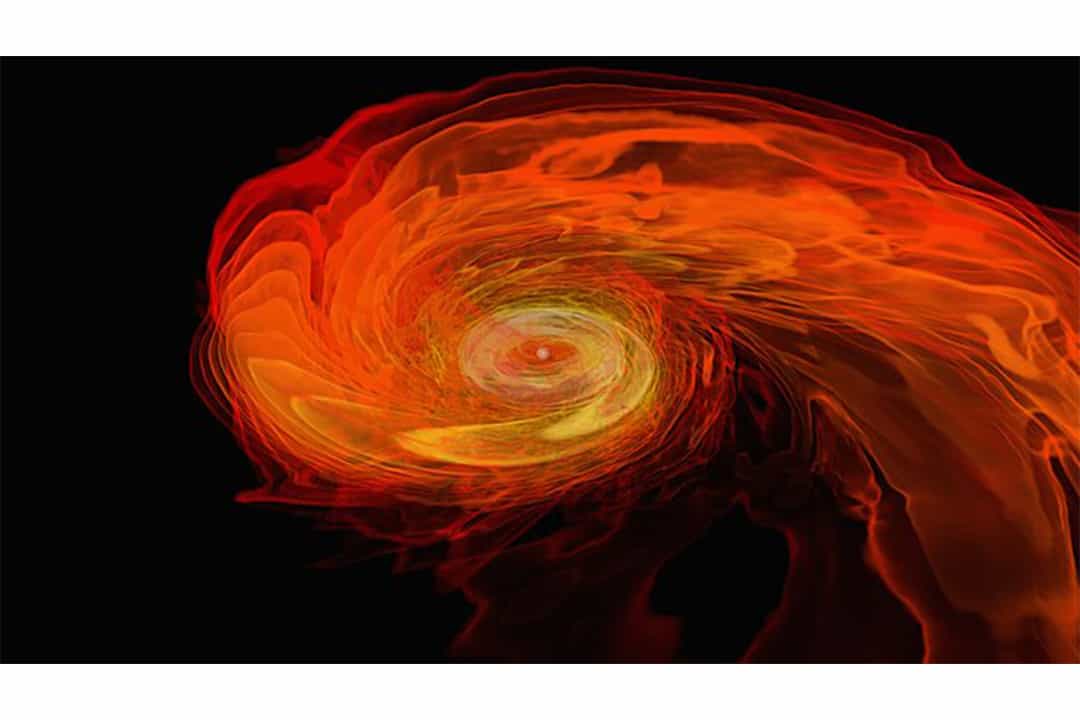What are neutron mergers, and why are they important? That is the question visiting professor Elias Rolant Most from the California Institute of Technology addressed on the evening of November 16 in a lecture hall at McLennan Physical Laboratories. The lecture was titled “Neutron Star Mergers: Frontiers in Computational Relativistic Astrophysics.”
A neutron star merger is the collision of two neutron stars — really dense stars composed mainly of subatomic particles called neutrons. These powerful collisions in the cosmos provide a “frontier” of study where many fields of physics intersect and through which researchers can study the most fundamental forces of physics.
But before we talk in more detail about neutron star mergers, we have to address the protagonist: neutron stars.
Neutron stars (Please, I’m a star)
Neutron stars are composed mainly of neutrons with perhaps a few protons. A neutron star is the end state in the life cycle of a star that is about eight to 25 solar masses. One solar mass is the mass of our sun, which is approximately 2 × 1030 kilograms — the mass of more than 330,000 Earths! The interesting thing about these stars is that they are relatively small, around 30 kilometres in diameter, yet can weigh multiple times the weight of our sun, which is around 1.4 million kilometres in diameter.
Consequently, a neutron star has a very high amount of mass confined to a small space. These conditions lead to a lot of cool things, like nucleosynthesis, happening inside the neutron star because of its makeup. Nucleosynthesis is when protons and neutrons form new atomic nuclei and occur during neutron star mergers. Nucleosynthesis only happens during really high-energy events like neutron star collisions — as well as supernovas, which are massive star explosions, and the Big Bang, which is the theory that the universe started and expanded from a single intensely dense point, leading to the formation of the stars, planets, and everything else.
Neutron stars are also where matter exists in its most extreme form. Essentially, matter exists in these stars in the highest stable density possible with the highest gravity possible without them devolving into full-on black holes. Black holes are extremely dense astronomical regions with such high amounts of gravity that not even light can escape their pull.
According to Professor Most, this makeup essentially sets up the neutron star as a “cosmic laboratory of nuclear space goo” that can be “used to study [physics’] fundamental forces in their most extreme regime.”
Neutron star mergers
Two neutron stars in close proximity will often leave their orbits due to the attractive gravitational forces between them. This is how a merger begins. These stars start to orbit each other, and because of their high mass, they create ripples through spacetime as they accelerate, emitting detectable gravitational waves.
When neutron stars merge, they become a hot blob of dense nuclear matter throwing out neutron-rich debris. This collision is extremely quick, just around 15 milliseconds. Finally, these two stars can collapse under their own gravity and become a black hole.
According to Professor Most, researchers first directly detected a gravitational wave signal from a neutron star “coalescence” as early as 2017, with many other neutron star detections following.
Physicists have fiercely researched these mergers in the last few years through computational relativistic astrophysics, or, as Professor Most describes it, “[using] computers to paint pretty pictures.” Essentially, relativistic astrophysics refers to how astrophysical components like gravity, star collapse, and the Big Bang impact space-time, and it requires Einstein’s theory of relativity to understand. The “pretty pictures” are computational models that physicists use to study and make predictions about these components.
Gravity as told by Einstein
Einstein’s theory of general relativity portrays gravity as a bending of space-time by some mass, similar to how a trampoline bends under a weight placed on it. Gravitational waves are essentially the ripples in the fabric of space-time created by massive objects accelerating. The larger the speed or mass of an object, the stronger the ripples will be.
Because of the high mass and acceleration of neutron stars, the gravitational waves they emit are considerably strong and, as a result, detectable by human tools.
However, gravity is only one of the components researchers need to model these mergers. Physicists also need to consider electrodynamics, for example, which deals with electromagnetic waves like light and is a big component of neutron star mergers. After all, light, gamma rays, and radio waves are all emitted or involved in the merger. Not to mention, weak chemical interactions within the star itself also impact the way the stars merge.
With so many components to look at, how do physicists even go about trying to layer these perspectives to make one workable model for neutron star mergers?
The art of computational simulations
Turns out, there is no one workable model. Physicists from various disciplines offer unique perspectives that add to the picture of neutron star mergers. Computational relativistic astrophysicists create simulations that can make predictions and make sense of what is happening at these events.
Depending on what assumptions a physicist makes and the lens from which they choose to view these stars, the simulations or pictures change drastically, which is why it’s important to choose an appropriate measuring or imaging tool for the physical component the researcher wants to study.
For example, the collapse of a pulsar — a rapidly rotating neutron star emitting radiation at regular intervals — releases a burst of electromagnetic energy. Viewing these bursts using X-ray waves versus radio waves gives completely different pictures of what’s happening during the collapse.
While there are additional challenges in studying neutron stars, research in the field has developed in leaps and bounds in just the last few years, thanks to passionate scientists like Professor Most. By assembling all these tools from various physics fields, physicists can still make really accurate pictures of something happening at a cosmic lab light years away from us.
neutro



No comments to display.